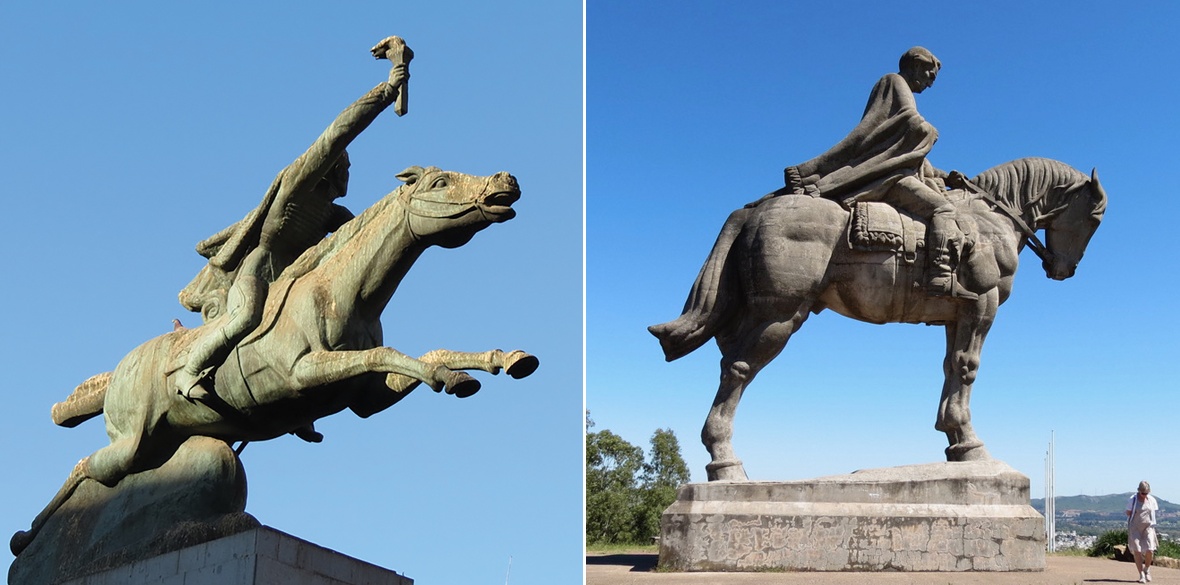This is the last article you can read this month
You can read more article this month
You can read more articles this month
Sorry your limit is up for this month
Reset on:
Please help support the Morning Star by subscribing here
WHILE equestrian statues are probably the most ubiquitous of all public monuments in Western towns and cities, their aesthetics are predictably formulaic.
Three or four standard formats are replicated ad nauseam and most are offensive examples of wars waged by the rapacious elites of any given country.
Roman emperor-philosopher Marcus Aurelius, whose 2,000-year-old equestrian statue is the oldest complete one in existence, is without armour or weapons as befits a supposed bringer of peace.
Cast in bronze in extraordinary detail, the statue inadvertently counsels caution to artists seeking to curry favour with their subject — the oversized emperor sits comically astride what appears to be an overgrown pony.
In contrast to that iconic, albeit flawed, work, a spectacular sense of innovation and sculptural bravura garces the Bustamante Park in Chile’s capital Santiago.
There, an equestrian statue encapsulates the spirit and endeavour of Manuel Rodriguez, the legendary figure of Chile’s war of independence from Spain. He was assassinated on the orders of the “official hero” Bernardo O’Higgins in May 1818.
The statue represents an exhilarating harmony between rider and horse, projecting a sculptural wholeness which makes them appear as if they are swiftly flying through the air. More unusually — perhaps even uniquely — its creator was a woman, Blanca Merino.
The sculpture symbolises Rodriguez’s fearlessness, audacity and courage as he carries the flame of freedom in his right arm.
Rodriguez commanded a fiercely loyal and effective crack guerilla detachment called Hussars of Death. During the Pinochet dictatorship, the Chilean Communist Party’s military wing adopted his name — the Frente Patriotico Manuel Rodriguez — for the popular armed resistance.
In today’s Chile, the spirit of Rodriguez embodied in this stupendous sculpture has inspired and informed the resilient popular rebellion that will surely see Pinochet’s odious legacy consigned to the dustbin of history.
Like Rodriguez, Uruguayan Jose Gervasio Artigas was a man of integrity who paid a high price for his loyalty to common people and advocacy of progressive political ideals during the very same war of independence against Spanish colonial power.
Although a trained military officer he was, like Marcus Aurelius, a thinker and theoretician who wrote extensively on economics and politics, which helped inform his own political vision for a modern federation of Rio de la Plata (River Plate).
His ideas on wealth redistribution and separation of executive, legislative and judicial powers did not sit well with emerging oligarchic elites on both sides of the river, which were about to replace the Spanish exploitation with one of their own.
Artigas was disparaged and hounded out of Uruguay. Offered asylum in Paraguay, he lived there until death on a modest farm among Indians and peasants who called him in Guarani Carai Marangatu (Father of the Poor).
His gigantic, 18-metre-tall, reinforced concrete sculpture by Setillo Belloni is the second-largest equestrian sculpture in the world, after the 40-metre-tall Genghis Khan statue near Ulaanbaatar in Mongolia.
Seated on top of the 280-metre-high hill Cerro Artigas outside the small 18th-century industrial town of Minas (Mines) and 100km north-east of the capital Montevideo, in contrast to Merino’s Rodriguez it exudes a marked serenity and stillness.
Artigas, in an ordinary gaucho’s attire and saddle, his head lowered, is immersed in deep thought. The austere, modernist articulation of shape and detail aids the sculpture’s superb monumentality, profundity and grace.
It’s an impeccable rendition of the man who inspired generations of Latin American revolutionaries, including Luis Carlos Prestes, Ernesto “Che” Guevara, Juan Velasco Alvarado and Uruguay’s socialist president Jose “Pepe” Mujica.








